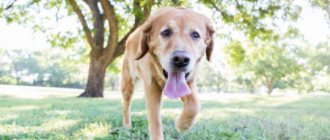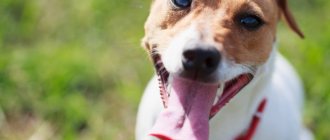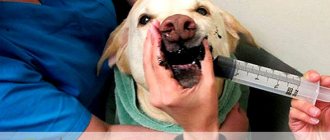Due to the fairly high level of motor activity, injuries in dogs are much more common than in other domestic animals. Moreover, not only large breed animals suffer, but also decorative dogs, which sometimes rarely leave the apartment.
In some cases, the complexity of the injury allows the animal owner to provide emergency assistance himself, ensuring a quick recovery and complete rehabilitation. If the situation is serious, then the best solution would be to consult a veterinarian in a certified clinic. To do this, the owner needs to detect signs of injury in the dog in time and provide it with proper care until a veterinarian takes care of the animal.
Causes of injuries in canines
Dogs are very active animals, and this activity leaves an imprint on their anatomy, physiology and psychology. Representatives of most breeds (with the exception of a number of purely decorative ones) are distinguished by noticeable “strength”, so that often the symptoms of injury in dogs go unnoticed by the owners, and the animal recovers quickly without outside help.
But there are still a number of reasons that can lead to serious damage to the body. Among them:
- Contact with the vehicle. Car injuries to dogs are a phenomenon typical for most cities, especially for such large ones as Moscow. Such injuries are complex and multifaceted, and often end fatally - the animal dies either at the moment of impact or some time after it due to the inability to provide assistance in the required amount.
- Fights. 90% of cases are fights between dogs and representatives of their own species, the remaining 10% occur among cats and birds (a dog’s eye injury is a common result of a “conflict” with jackdaws or crows). During fights, damage can be very different: it all depends on the aggressiveness and weight categories of the participants. Usually the result is damage to the skin, sometimes muscles, accompanied by bleeding of varying degrees of intensity.
- Falls. Falling from a height, from uncomfortable steps, or simply tripping on a slippery surface, animals most often break limbs or suffer concussions.
First signs
A dog that has suffered a concussion may behave normally with a minor injury. With more severe injuries, the following signs and symptoms of a dog concussion occur:
- Lethargy, inert behavior, apathy. These are usually the first signs of a mild concussion.
- Headache, due to which the animal either tries to keep its head unnaturally straight and still, or shakes it vigorously.
- Impaired coordination of movements.
- Nausea, vomiting.
- Lack of appetite.
- The dog sleeps a lot, tries to hide from everyone, even from its owners.
- Loss of consciousness, unexpected fainting. Loss of consciousness is especially dangerous if the animal is constantly vomiting - it can choke on its own vomit.
- Inappropriate behavior up to and including attacks on its owner and strangers.
- In severe cases, breathing and heartbeat disturbances occur, and the pupils are dilated over the entire eye and do not respond.
Depending on the dog’s condition, appropriate assistance is provided.
Features of injury to dogs of large and small breeds
A typical list of reasons why pets can be injured has been described above. But differences in the anatomy and physiology of different breeds also leave their mark on the specifics of injury:
- Large animals - Malamutes, Great Danes, Mastiffs, Newfoundlands and other breeds - are predisposed to limb injuries primarily due to the high load on the joints. Even if an animal stumbles on the stairs, it can suffer a dislocation or sprain simply because the joint receives a short-term load that exceeds its capabilities.
Important! This is one of the reasons why it is necessary to control the body weight of large dogs and provide them with regular physical activity to strengthen the joints and ligaments.
- Medium breed dogs are injured mainly in fights or getting hit by a car. In the first case, there is a direct dependence of the severity of injuries on the breed. “Hierarchical” dogs (for example, huskies) fight actively, but receive almost no serious injuries, while breeds bred for close interaction with humans (Rottweiler, shepherd, large terriers) can actively injure their opponents.
- For small breed dogs, the main threat is... their owners and children. These animals are injured mainly due to a fall from a height: an unsuccessful jump from a sofa or from the owner’s arms leads to a dislocation, fracture or concussion.
In addition, helping small breed dogs with injury is difficult. The small size complicates the immobilization of the limbs, and the small mass creates difficulties for the owners when calculating the dosages of drugs (anaesthetics, painkillers).
What to do if the puppy fell from the sofa or bed (of a different height)?!
Careful observation of the condition and behavior of the puppy after a fall from a height is the main point of the owner. If the puppy is as active as before, there is no noticeable decrease in appetite and trips to the toilet do not raise any suspicions, then most likely the puppy is lucky. But this is not always the case. We cannot find out the state of the internal organs, so we should not relax.
If after a fall the puppy begins to limp, has lost his appetite, has become lethargic and tired, lies down more often than plays, then this is a reason to call a veterinarian for the puppy to examine and diagnose the condition of the internal organs. And taking measures to restore the puppy’s health after a fall from a height. In some cases, your pet may need x-rays.
In other cases, taking samples. And in other situations, surgical assistance from a veterinarian for a puppy.
If you notice any change in your puppy's condition after a fall, do not hesitate to call a veterinarian at home.
[custom_ads_shortcode2]
Bruises
A dog's bruise is a fairly common injury, but rarely noted by owners. This is due to the fact that the animal’s pain threshold is quite high, so bruises without external signs (severe swelling or crushing) go unnoticed under the fur.
A bruise occurs when struck by a blunt object, and is usually accompanied by either the appearance of a bruise or the formation of a subcutaneous swelling (hematoma):
- In the first day after a bruise, it is advisable to limit the spread of swelling by applying cold to the damaged area.
- After 24 hours, minor bruises go away on their own. If the hematoma remains, it is advisable to warm it up (a heating pad, a bandage with heated salt) for 15-20 minutes 3-4 times a day.
- The skin at the site of the bruise is lubricated 2 times a day with special ointments that resolve the hematoma.
How to Prevent Concussions
Because concussions, except in very severe cases, usually occur as a result of accidents, they are difficult to prevent. Keep your dog away from high places, away from falling objects, and keep a close eye on him when walking around town to make sure he doesn't get hit by a car.
You can keep her tied up, away from angry animals, away from high-profile performances, and confined to your home to keep her out of trouble. Being a good pet owner depends on being vigilant and avoiding injury to your dog.
However, accidents are an inevitable part of pet ownership, but being prepared to deal with brain injuries can help your dog receive the best treatment.
Sprains
A sprain, unlike a bruise, occurs when there is awkward movement in a joint. The main symptom is pain during intense movement or jumping, as well as when palpating the problem area. In the absence of ligament rupture, the sprain usually resolves without consequences.
Recommendations for helping with sprains:
- Limiting the animal’s mobility (it’s enough just not to force the dog to run and jump - it takes care of the damaged joint itself).
- Cold on the first day after injury, warm the next 2-3 days.
With such injuries in dogs, treatment in the clinic is not required as often. The exception is situations when bruises accompany more serious injuries (they almost always accompany fractures). It is also worth contacting your veterinarian if the symptoms of sprain do not go away within 3-4 days.
Consequences
The consequences of the condition depend on the extent of the damage and the severity of the injury. If the level of nerve damage is high, mobility impairments, paresis and paralysis, impaired coordination of movement, vision and hearing, intestinal atony and other dangerous problems may occur.
With minor injuries, the injured animal can fully recover without any consequences for the body and its functioning.
Dislocations
A dislocation is an injury that affects a joint. When a dislocation occurs, the natural position of the articular surfaces is disrupted, and they cannot spontaneously return to their place. Characteristic features:
- Swelling at the joint (swelling and inflammation occur at the site of tissue damage).
- Soreness of the damaged area.
- Restricted mobility in a joint or, conversely, unnatural mobility (the limb bends in a way it shouldn’t).
When a dislocation occurs, it is important to ensure basic immobilization of the animal's limb so that bone displacement does not cause additional damage. After this, the dog should be taken to the clinic as quickly as possible - under no circumstances should you adjust the dislocation yourself. Severe dislocations can be extremely painful, so pain relief for a dog with this type of injury is given quite often - this helps to avoid shock.
Note! It is also undesirable to apply cold to the site of dislocation - cooling the joint can make it difficult to reduce it. Therefore, it is necessary to cool the injury site only for a short period of time, and only if the animal feels severe discomfort.
Rules for caring for animals
If a dog has symptoms of a concussion, it is necessary to ensure complete rest for the animal. The pet should be placed in a quiet, darkened room. It should be remembered that any sharp sounds intensify headaches and cause anxiety.
It is necessary to protect the animal from playing with small children. You should also temporarily avoid taking your pet out for long walks. Dog training should be delayed until the dog's concussion symptoms have completely resolved.
It is also important to protect the animal from hypothermia. The room in which the pet lies must be warm. You should also pay attention to feeding. During the period of illness, the dog should be given light food so as not to provoke vomiting. It is useful to switch your pet to special dietary food.
Fractures
Unlike a dislocation, a fracture is not accompanied by displacement of the bones in the joint, but by a violation of the integrity of the bone. Most often, fractures affect the limbs, but if the cause of the dog’s injury was a car accident, then the animal may receive multiple fractures.
The optimal strategy for a fracture is to deliver the animal to the veterinary clinic as quickly as possible:
- The damaged area is immobilized in order to minimize tissue damage when bone fragments are displaced. For immobilization, thick bandages or splints made from scrap materials are used.
- Open wounds are treated and covered with sterile dressings.
- The fracture site is cooled to reduce pain.
Today, the main method of treating fractures in dogs is osteosynthesis - the installation of metal fixing elements directly into the body of the bone or on its surface. The osteosynthesis operation is performed under general anesthesia, after which the dog must undergo rehabilitation within a month. As a rule, with timely veterinary care, the bones heal well, and the consequences for the animal’s health are minimal.
Symptoms of a serious dog condition
If the owner witnesses that the puppy has fallen from a sofa, bed or other small height, then the pet’s health must be closely monitored. If the baby is not worried, his gait has not changed, lameness has not been noticed, appetite and thirst are preserved, and no pathologies from the urinary and digestive systems are detected, then there is no reason for alarm.
However, a fall from a height does not always end well for a dog. Veterinary experts strongly recommend that owners seek qualified help if the animal exhibits the following symptoms in the event of an unsuccessful landing:
- Coordination of movement is impaired. Your four-legged friend may experience lameness, unsteadiness, and a stiff gait. In severe cases, the animal cannot stand on its feet.
- A fall from a height in a dog is often accompanied by a violation of the act of urination and defecation. Spontaneous bowel movements and bladder emptying indicate serious spinal injury or neurological syndrome due to brain damage. The cause of the disorder of physiological functions can be bruises and blunt injuries of internal organs (kidneys, bladder).
- Neurological manifestations - convulsions, paralysis of the limbs, trembling of the eyeball, lack of reaction of the pupil to light, nystagmus - are signs of severe damage to the central nervous system of the animal, requiring immediate veterinary care.
- The dog whines and worries. The apathetic, lethargic state of the pet should alert the owner. Difficulty breathing, drooling, bloody foamy discharge from the mouth or nasal cavity, vomiting, refusal of food and water - a reason for an early visit to a specialized institution and a call to the home of a veterinary specialist.
The owner should be alerted not only to a deterioration in appetite, but also to difficulty in eating. Brain damage often manifests itself in the form of a contusion - the dog grabs food, but chokes and cannot swallow.
[custom_ads_shortcode3]
Wounds and bleeding
A wound is one of the most common injuries in dogs. Most often, this term refers to any injury accompanied by damage to the skin. Bleeding almost always begins when the dog is injured, but sometimes it can appear later - this is typical, for example, of injuries received in a fight with other animals.
According to the type of application and the nature of damage to the skin and tissues, wounds are divided into:
- Biting is a consequence of a fight with another dog or cat.
- Torn - can be obtained in a fight or due to severe damage. They are characterized by significant size, profuse bleeding and tearing off flaps of skin. Injuries to claws in dogs that are excessively long can also be accompanied by lacerations: the claw, acting as a lever, simply tears off the skin and injures blood vessels.
- Cuts - dogs most often get them by stepping on glass or other sharp objects. Accordingly, the paw pads are usually affected, and the extent of the damage directly depends on the dog’s weight.
- Split - characterized by a small area and large depth of penetration. This often happens if the dog runs into a nail or sharp object. Most cases affect the trunk rather than the limbs. The main danger of a puncture wound is hidden damage to internal organs.
- Gunshots are another very dangerous category of wounds. With a gunshot wound, a bullet, shot or buckshot can penetrate deep into the body, causing heavy bleeding - both internal and external.
A wound is not always a reason to visit a veterinarian. The regenerative abilities of dogs are very good, so minor damage to the skin heals either without human intervention or with a little help from the owner.
When processing independently:
- The wound is cleaned of dirt and objects that have gotten into it.
- Torn small fragments of skin are also carefully removed (it is better to do this right away, because the likelihood that a thin flap will take root is small, but it may begin to rot).
- The wound is washed and treated with an antiseptic.
- The edges of the wound are tightened and fixed with a sterile bandage.
- After primary healing has begun, the damaged area is treated with creams and ointments.
If the wound is deep and extensive, there is heavy bleeding or there is a risk of damage to internal organs, you need to take the dog to a veterinarian as soon as possible. In this case, the main task of the owner is to stop bleeding and prevent infection of the wound:
- To stop bleeding, it is necessary to clamp the vessels through which blood flows. This is done manually, using a pressure bandage or tourniquet.
- You can prevent the wound from becoming infected by covering it with a sterile cloth and securing it with a bandage.
Diagnostics
If a concussion is suspected, the veterinarian will order the following tests:
- MRI of the brain. This test helps determine the extent of traumatic injuries.
- X-ray. Using this method, bone damage can be determined.
- Electroencephalogram. The examination helps to identify the hidden consequences of injury.
It is necessary to show your pet to a veterinary ophthalmologist for a fundus examination, as well as a neurology specialist to assess reactions to stimuli.
Internal organ damage in dogs and other injuries
In addition to the injuries described above, dogs can suffer from other injuries:
- A dog's abdominal injury due to a blow is almost always accompanied by bruises of internal organs or even ruptures. Such damage is dangerous primarily due to non-obvious symptoms: they have few external manifestations, and one can only suspect something is wrong by the dog’s behavior.
- A dog's fecal incontinence after an injury, problems with coordination of movements, and limb failure are symptoms of spinal cord injury. They can appear either immediately or some time after the animal has been injured - in the second case, the cause is swelling or tissue necrosis.
- Traumatic brain injury in a dog usually results from hitting its head on a hard object or the ground. It is accompanied by loss of orientation and coordination of movements, vomiting. A concussion, which occurs with closed head injuries, can go away on its own - but only the attention of a doctor will ensure the absence of serious consequences.
- Injury to the dog's cornea is another common problem in active breeds. It is accompanied by profuse secretion of tears and, if severely damaged, is painful. If the cornea is severely damaged (i.e. the damage is visually noticeable or washing the eye with water does not help), it is necessary to take the dog to the veterinarian as quickly as possible.
How we are working
Our car will arrive shortly after your call, and we will deliver the animal to the clinic, taking all precautions. A visual inspection will be carried out on site, and anti-shock and painkillers will be administered. After this, if necessary, hardware diagnostics are carried out (radiography, ultrasound, etc.).
), resuscitation measures are carried out, fixing bandages are applied, a decision is made on urgent surgery and further measures to rescue or rehabilitate the dog. Our specialists have extensive experience treating four-legged animals injured as a result of a fall from a height. We will do everything possible to save the life and restore the health of your pet.
Puppies are curious and explore and test everything. It is not uncommon for puppies to try to climb onto a sofa, bed, or other height. Trying to conquer the next peak (sometimes seeing how easily a cat living in the same home does it), the puppies do not calculate their strength and fall to the floor. Or simply having conquered, for example, a sofa, they unsuccessfully try to get off it and hit the floor or some hard object. Unlike kittens, puppies do not know how to group themselves as well as a cat does when falling. Therefore, after falling from a height, puppies are injured more often.
How can a puppy fall from a height be dangerous? The main consequences of a puppy falling from a height:
- Head injury (concussion);
- Dislocation of limbs, up to broken paws;
- Injury to internal organs;
- State of shock;
- Other injuries.
[custom_ads_shortcode1]
Recommendations for rehabilitation of dogs after injury
A dog's recovery from injury is a very important process that the owner must strictly control. The first and most important rule is strict adherence to the veterinarian’s recommendations regarding the rehabilitation period. These recommendations differ for different types of injuries in dogs, but the general algorithm remains the same:
- In order for a dog to recover faster after an injury, it is necessary to limit its physical activity. The exception is fractures of the limbs (for example, a hip injury in a dog), in the treatment of which osteosynthesis is used: in this case, dosed loading from the first days promotes the healing of bone tissue.
- It is important to avoid scratching and gnawing on bandages and stitches. Sometimes treating wounds and scars with drugs that have an unpleasant taste and odor (like Chlorhexidine) helps. But some animals ignore this treatment - it is advisable for them to wear special collars.
- If general anesthesia was used during treatment, feeding should be postponed for at least 12 hours (it is highly likely that the dog will not eat on its own). But access to fresh water should be as easy as possible: place the drinking bowl next to the dog’s bed.
- The use of painkillers and antibiotics is only as recommended by a veterinarian. If the animal experiences obvious discomfort, it is advisable to return to the clinic for consultation.
And remember that the rehabilitation process after injuries, especially severe ones, can take up to 3-4 months. Therefore, even a seemingly healthy dog should not be subjected to excessive stress in order to avoid complications.
Treatment methods
Mild to moderate concussions are treated on an outpatient basis. In case of severe injuries, the dog should be hospitalized.
In order to prevent cerebral edema, intravenous (drip) and intramuscular administration of the following drugs is prescribed:
- "Mannitol";
- "Calcium chloride";
- "Furosemide".
To avoid the severe consequences of injury, veterinarians administer nootropic drugs to animals:
- "Mexidol-vet";
- "Cerebrolysin";
- "Actovegin";
- "Piracetam."
Symptomatic treatment is also indicated:
- For headaches, analgesics are prescribed: “Baralgin”, “Travmatin”.
- For nausea, antiemetics are indicated: “Cerucal”, “Ondasetron”, “Serenia”.
- After severe injuries, medications are prescribed to maintain cardiac activity: “Cordiamin”, “Caffeine-vet”, “Sulphocamphocaine”.
- If the dog shows signs of agitation and aggression, then the administration of sedatives is indicated: Clonazepam, Vetpokoin, Seduxen, Spitomina.
- To generally strengthen the body and accelerate regeneration processes, vitamins and immunomodulators are prescribed: “Gamavit”, “Neurobeks”, “Vitam”.
It is important to remember that only a veterinarian can prescribe medications and determine their dosage. Self-treatment in this case is absolutely unacceptable.
The length of treatment for a concussion in a dog depends on the extent of the injury. The animal does not immediately recover from injury. For mild bruises, therapy and recovery period take several weeks. For severe injuries, rehabilitation can last many months.
First aid and treatment of injuries in a veterinary clinic
In the previous sections, we focused on the symptoms of injuries in dogs and the first aid that the owner of the animal can provide. But the main recommendation remains the same - if the severity of the injury causes at least minimal concern for the health or life of the animal, the dog should be taken to a veterinary clinic as quickly as possible.
Our Aquarius clinic provides first aid and performs all treatment procedures for injuries in dogs. The main arguments in favor of contacting us:
- Prompt telephone consultations – both before the start of treatment and during rehabilitation.
- Highly qualified doctors and extensive experience in professional veterinary care for injuries of varying complexity in dogs of small and large breeds.
- Modern equipment, including diagnostic equipment and fully equipped operating rooms for surgical interventions.
- Comprehensive postoperative care in a hospital, ensuring rapid recovery from injuries.
Even the most attentive owner will not be able to 100% protect his dog from injury. But we can recognize the damage in time, provide first aid and deliver the pet to the veterinarian as quickly as possible for quick and effective treatment!
Injury Prevention
Considering the factors that lead to pets falling from heights, veterinary specialists and experienced dog breeders recommend that owners adhere to the following rules and recommendations:
- Walk your pet in specially designated areas and areas with a fence. Regularly check the area for safety, make sure that there are no open sewer wells or other technical structures on the walking area.
- Cultivate in your pet a tolerant attitude towards relatives and cats, and do not allow them to chase animals.
- Do not leave your four-legged friend in potentially dangerous places - on the balcony, open window, on high furniture.
- Miniature breeds should only be walked on a special harness that prevents the pet from slipping out of your hands.
We recommend reading about traumatic brain injury in dogs. From the article you will learn about the causes and types of TBI, symptoms, consequences for the animal, drug and surgical treatment.
And here is more information about paralysis in dogs.
Falling from a height is not a common injury for dogs. Nevertheless, the owner of a puppy, a dwarf pet, or an overly active representative of a large breed must be prepared to provide competent first aid. A fall from a height often has long-term consequences for a pet's body. Therefore, even in the absence of symptoms such as lameness, loss of appetite, impaired urination and defecation, the animal should be shown to a veterinarian.
Regarding dogs
From the very beginning, you need to teach your dog to walk on a leash/harness. You can allow him to walk without a leash on your private territory or in special fenced-off areas.
It is clear that sometimes you want your pet to run free, but what can this lead to? A dog can easily get hit by a car passing by, and the reasons for this can be various situations: it saw another animal or a familiar person on the opposite side of the road, ran out to get a ball, or was frightened by a loud noise.
First aid
If your dog has a concussion, it definitely needs help. To do this, perform the following steps:
- You need to remove the dog's collar, muzzle, and everything that may hinder its movements and breathing.
- Place it on its side on a flat, hard surface.
- Remove the tongue so that if she loses consciousness, she cannot choke or suffocate on it.
- Check pulse and breathing.
- Apply a cold compress to your head (you can use an ice pack).
- Seek veterinary help.
If your dog has been hit by a car, or has additional injuries, especially fractures and open wounds, you should try to call an emergency veterinarian or a doctor at home.
Classification
Lameness in animals can manifest itself in different ways, so it is divided into several types:
- Lameness of a hanging limb.
The dog presses the sore paw and holds it suspended while moving. This symptom is typical for mechanical injuries (sprains, ligament tears, fractures, bruises, cuts) and acute inflammatory processes of the musculoskeletal system (osteoarthritis).
- Lameness of a supporting limb.
The dog does not fully lean on his sore leg. Tries to quickly shift the center of gravity to the healthy paw, falling on it.
- Intermittent claudication.
This type is characterized by periodic occurrence of disturbances in the animal’s gait. It is a subtype of lameness of a supporting limb. Occurs after sleep or after the dog lies down. In large breeds this may be a symptom of joint dysplasia, in small breeds it may be Perthes syndrome or a luxating patella.
Dog falling from height
But the owner himself can help his pet. First of all, if your pet is wearing a collar, it needs to be removed. This will make your dog's breathing easier.
You should also apply a cold compress. This could be a bag of cold water, a heating pad with ice, etc.
Also, if possible, you need to remove the animal’s tongue to avoid tipping over and suffocation.
If the pet has lost consciousness, then it is necessary to place it on a hard surface. If the heartbeat stops and breathing disappears, external cardiac massage with artificial respiration is performed. It is performed by blowing air through the nasal cavity. At the same time, the mouth is clamped with hands. At least ten blows per minute and about 60 presses per minute, that is, one press per second in the chest area.
Dog falling from height
This doesn't happen often, but there are times when a dog falls from roofs, barns, the back of a car, a balcony, a mountain, a bridge, and so on.
It must be taken into account that injuries sustained in a fall are always associated with serious damage. The nature of the damage can be judged by how the animal landed when it fell. If the dog lands on its paws, the limbs will be damaged, especially the hind limbs (bruises, bone fractures, pelvic injuries, dislocations, spinal injuries). Since a dog’s head generally has a lot of weight, when it falls, the neck muscles are unable to support the weight of the head. Because of this, the head hits the ground hard when it hits the ground. A concussion occurs, as well as damage to the cervical vertebrae, and there may be a fracture of the lower jaw. If a dog falls on its side, a rib fracture usually occurs. The most dangerous damage to internal organs: kidneys, liver, large vessels, spleen, internal bleeding develops. In such a situation, it is almost impossible to determine the extent of damage. In this regard, first aid should be aimed both at visible injuries and at the prevention of suspected disorders of blood vessels and internal organs.
First aid if a dog falls from a height: 1. Place the animal on its healthy side.










